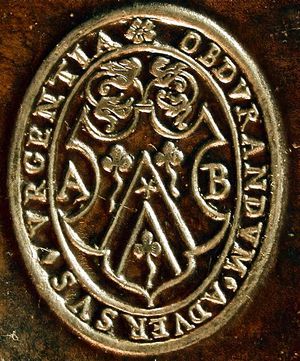Adam Bothwell ca.1529-1593
Adam BOTHWELL, Bishop of Orkney, ca.1529-1593
Biographical Note
He was the second son of Francis Bothwell of Edinburgh, a Lord of Session, and Katherine Bellenden. He came from a well-connected Edinburgh family with links to local politics and the King’s government. Not much is known of his early life, though it is likely he studied at the University of Orléans. Bothwell’s first post in the Church was as a prebend of Glasgow Cathedral (1522), and he later became minister of Corstorphine near Edinburgh, where he had inherited property. He married Margaret Murray (d. 1608), daughter of John Murray of Touchadam, with whom he had six sons and two daughters. In 1555, Bothwell went on government business to Orkney, and in 1559 was nominated bishop of Orkney. He joined the reformers, and during the 1560s was part of the committees revising the Book of Discipline. In 1564 he was appointed an Extraordinary Lord of Session. He celebrated the marriage of Mary Queen of Scots to the Earl of Bothwell, and officiated the baptism of James VI. This was suspicious conductor in the eyes of the reformed Church, and ultimately led to the loss of his bishopric, which he exchanged for the commendatorship of Holyrood Abbey in 1569.
Books
Bothwell was one of the major book collectors of sixteenth-century Scotland. Over the course of his life he assembled a wide-ranging Humanist library with works of theology, medicine, astronomy, and law all represented in the 1594 inventory of his library. These were written in Latin, French, Hebrew, Italian, and Greek (with a few books in English). The inventory also lists a copy of the Malleus maleficarum and Bodin's history of the witchcraft persecutions De la démonamanie des sorciers. Surviving volumes indicate that a significant number of Bothwell’s books were printed in Switzerland. His library was especially rich in Swiss and German reformers, such as by Heinrich Bullinger, Johannes Oecolampadius and Urich Zwingli.
Some examples of books which formerly belonged to Bothwell are: Theodor Zwinger’s encyclopedia Theatrum vitae humanae, printed by Froben in Basel in 1571 (St Andrews University TypSwB.B71FZ), and subsequently owned by the Rev. William Annand (1633-1689).
A polyglot bible, printed in Heidelberg in 1587. (Edinburgh University X5.a.1), likely also owned by Annand. Phillip Melanchton’s popular history textbook Chronicon Carionis (Geneva, 1581) (Edinburgh University *Q.21.41)
The works of St Jerome printed at the Froben press in 1537, and later owned by Thomas Sydserff. (NLS RB.l.18)
Commentarius verborum juris (Basel, 1558), a reference work on law by the French Calvinist jurist François Hotman (Edinburgh Napier B 147).
Characteristic Markings
Bothwell used an armorial stamp on his bindings, with the motto Obdurandum adversus urgentia. He also regularly inscribed his books with variations of “Ex libris adamj epi. orchadej.” & “Adamus Episcopus Orchadensis.” His copy of Zwinger (TypSwB.B71FZ) is inscribed “Adamis Boithuel”
Sources
- British Armorial Bindings
- Durkan, J. & Ross, A. Early Scottish Libraries, Glasgow, John S. Burns, 1961
- Shaw, Duncan. ‘Adam Bothwell, a conserver of the Renaissance in Scotland’ in I. B. Cowan and D. Shaw (eds). The Renaissance and Reformation in Scotland: essays in honour of Gordon Donaldson, Scottish Academic Press, 1983
Shaw, Duncan. "Bothwell, Adam (1529?–1593), bishop of Orkney." Oxford Dictionary of National Biography

